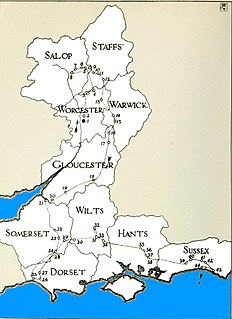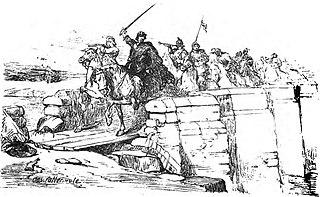 W
WThe Battle of Wigan Lane was fought on 25 August 1651 during the Third English Civil War, between a Royalist army led by the Earl of Derby and forces loyal to the Commonwealth of England under Colonel Robert Lilburne. The Royalists were defeated, losing nearly half their officers and men.
 W
WCromwell's Act of Grace, or more formally the Act of Pardon and Grace to the People of Scotland, was an Act of the Parliament of England that declared that the people of Scotland were pardoned for any crimes they might have committed during the Wars of the Three Kingdoms. It was proclaimed at the Mercat Cross in Edinburgh on 5 May 1654. General George Monck, the English military governor of Scotland, was present in Edinburgh, having arrived the day before for two proclamations also delivered at the Mercat Cross, the first declaring Oliver Cromwell to be the Protector of England, Ireland and Scotland, and that Scotland was united with the Commonwealth of England.
 W
WAfter the final Royalist defeat of the English Civil War against Cromwell's New Model Army at the Battle of Worcester on 3 September 1651, Charles the son of Charles I was forced to flee, famously avoiding detection by hiding in an oak tree in a wood that was being searched by Parliamentarian soldiers. A £1,000 reward was announced for information leading to Charles's capture. Relying on the support of a network of Royalist gentry, Charles first attempted to escape into Wales, then to Bristol disguised as a servant, then to the south coast at Charmouth disguised as an eloping lover. Finally, he rode east to Shoreham from where he took a coal boat to France on 15 October 1651.
 W
WGondibert is an epic poem by William Davenant. In it he attempts to combine the five-act structure of English Renaissance drama with the Homeric and Virgilian epic literary tradition. Davenant also sought to incorporate modern philosophical theories about government and passion, based primarily in the work of Thomas Hobbes, to whom Davenant sent drafts of the poem for review.
 W
WThe Navigation Acts, or more broadly the Acts of Trade and Navigation, was a long series of English laws that developed, promoted, and regulated English ships, shipping, trade, and commerce between other countries and with its own colonies. The laws also regulated England's fisheries and restricted foreigners' participation in its colonial trade. While based on earlier precedents, they were first enacted in 1651 under the Commonwealth. The system was reenacted and broadened with the restoration by the Act of 1660, and further developed and tightened by the Navigation Acts of 1663, 1673, and 1696. Upon this basis during the 18th century, the Acts were modified by subsequent amendments, changes, and the addition of enforcement mechanisms and staff. Additionally, a major change in the very purpose of the Acts in the 1760s — that of generating a colonial revenue, rather than only regulating the Empire's trade — would help lead to major rebellions, and significant changes in the implementation of the Acts themselves. The Acts generally prohibited the use of foreign ships, required the employment of English and colonial mariners for 75% of the crews, including East India Company ships. The Acts prohibited colonies from exporting specific, enumerated, products to countries and colonies other than those British, and mandated that imports be sourced only through Britain. Overall, the Acts formed the basis for English British overseas trade for nearly 200 years, but with the development and gradual acceptance of free trade, the Acts were eventually repealed in 1849. The laws reflected the European economic theory of mercantilism which sought to keep all the benefits of trade inside their respective Empires, and to minimize the loss of gold and silver, or profits, to foreigners through purchases and trade. The system would develop with the colonies supplying raw materials for British industry, and in exchange for this guaranteed market, the colonies would purchase manufactured goods from or through Britain.
 W
WThe Tender of Union was a declaration of the Parliament of England during the Interregnum following the War of the Three Kingdoms stating that Scotland would cease to have an independent parliament and would join England in its emerging Commonwealth republic.
 W
WThe Third English Civil War (1650–1651) was the last of the English Civil Wars (1642–1651). It consisted primarily of an invasion of Scotland by an English army controlled by the Rump Parliament and commanded by Oliver Cromwell and a subsequent Scottish invasion of England by a Scottish army loyal to King Charles II and commanded by David Leslie. It ended after 14 months with Scotland conquered and garrisoned by the English, Charles in exile abroad, the English Parliament in control of the British Isles and Cromwell as the most influential man in the new Commonwealth.
 W
WThe Battle of Upton was fought on 28 August 1651 when a New Model Army detachment under the command of Colonel John Lambert made a surprise attack on Royalists defending the river Severn crossing at Upton-upon-Severn, 6 miles (9.7 km) below Worcester. In the action which followed the Royalist commander Major General Edward Massey was severely wounded and the surviving Royalists were driven out of the town and north along the Worcester Road.
 W
WThe Battle of Warrington Bridge was a skirmish fought on 13 August 1651 between the invading Royalist Scottish army of Charles II and Parliamentary forces under the command of Major-General John Lambert.
 W
WThe Battle of Worcester took place on 3 September 1651 at Worcester, England, and was the final battle of the English Civil War, which began in 1642. Oliver Cromwell's Parliamentarian New Model Army, 28,000 strong, defeated King Charles II's 16,000 Royalists, of whom the vast majority were Scottish. The Royalist forces took up defensive positions in and around the city of Worcester. The area of the battle was bisected by the River Severn, with the River Teme forming an additional obstacle to the south-west of Worcester. Cromwell divided his army into two main sections, divided by the Severn, in order to attack from both the east and south-west. There was fierce fighting at river crossing points and two dangerous sorties by the Royalists against the eastern Parliamentary force were beaten back. Following the storming of a major redoubt to the east of the city, the Parliamentarians entered Worcester and organised Royalist resistance collapsed. Charles II was able to escape capture.